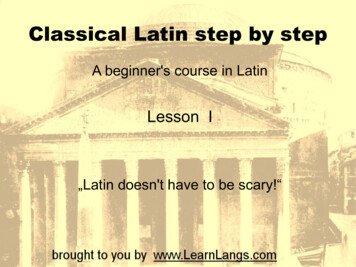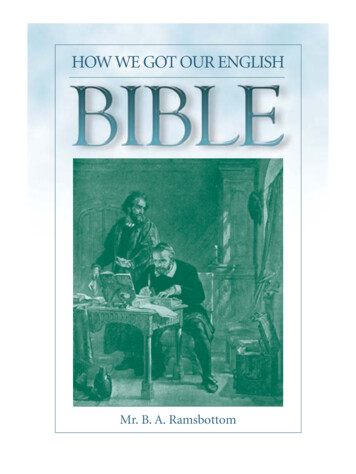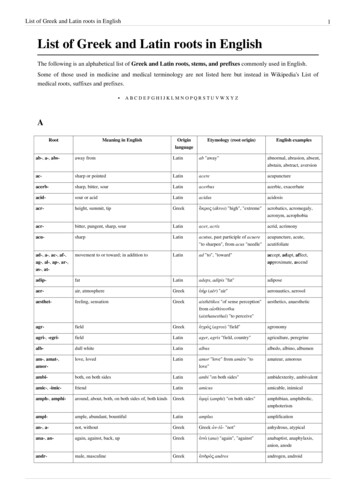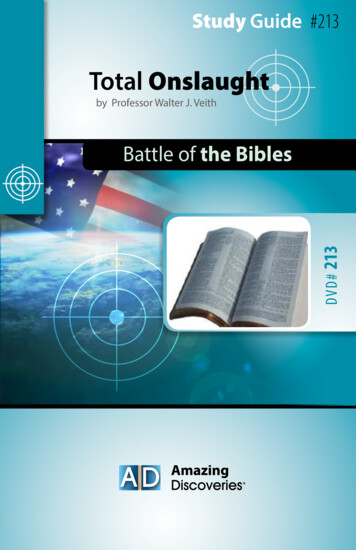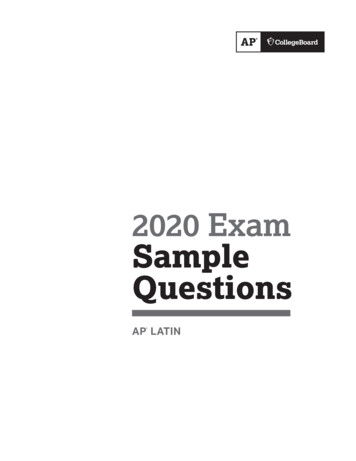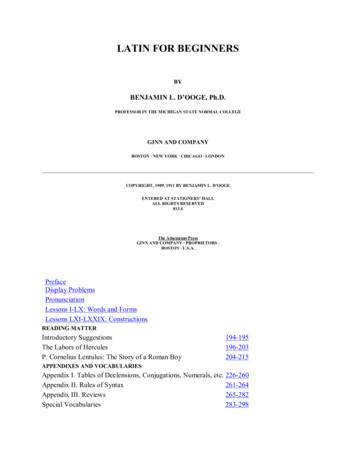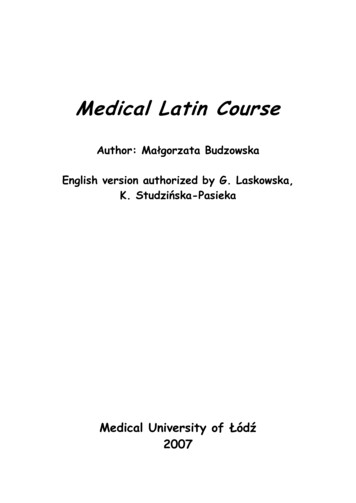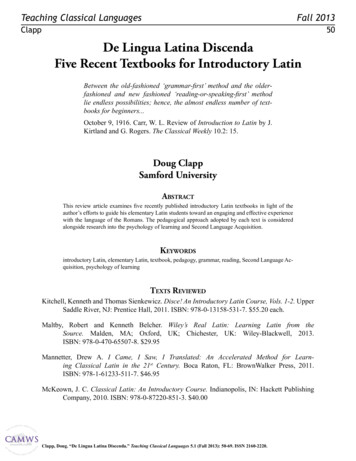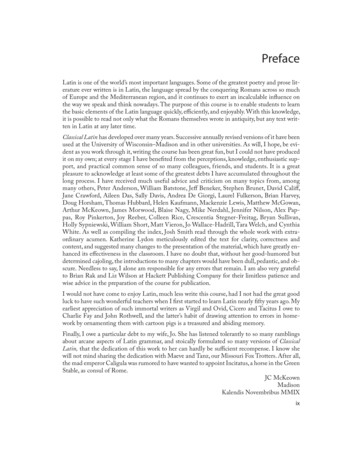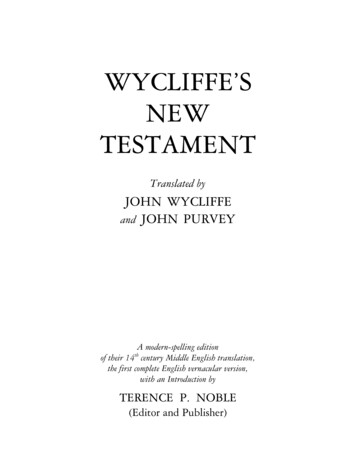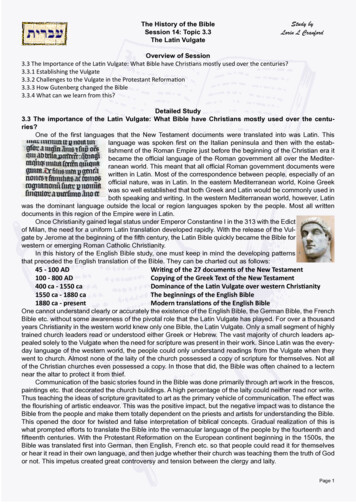
Transcription
The History of the BibleSession 14: Topic 3.3The Latin VulgateStudy byLorin L CranfordOverview of Session3.3 The Importance of the Latin Vulgate: What Bible have Christians mostly used over the centuries?3.3.1 Establishing the Vulgate3.3.2 Challenges to the Vulgate in the Protestant Reformation3.3.3 How Gutenberg changed the Bible3.3.4 What can we learn from this?Detailed Study3.3 The importance of the Latin Vulgate: What Bible have Christians mostly used over the centuries?One of the first languages that the New Testament documents were translated into was Latin. Thislanguage was spoken first on the Italian peninsula and then with the establishment of the Roman Empire just before the beginning of the Christian era itbecame the official language of the Roman government all over the Mediterranean world. This meant that all official Roman government documents werewritten in Latin. Most of the correspondence between people, especially of anofficial nature, was in Latin. In the eastern Mediterranean world, Koine Greekwas so well established that both Greek and Latin would be commonly used inboth speaking and writing. In the western Mediterranean world, however, Latinwas the dominant language outside the local or region languages spoken by the people. Most all writtendocuments in this region of the Empire were in Latin.Once Christianity gained legal status under Emperor Constantine I in the 313 with the Edictof Milan, the need for a uniform Latin translation developed rapidly. With the release of the Vulgate by Jerome at the beginning of the fifth century, the Latin Bible quickly became the Bible forwestern or emerging Roman Catholic Christianity.In this history of the English Bible study, one must keep in mind the developing patternsthat preceded the English translation of the Bible. They can be charted out as follows:45 - 100 AD100 - 800 AD400 ca - 1550 ca1550 ca - 1880 ca1880 ca - presentWriting of the 27 documents of the New TestamentCopying of the Greek Text of the New TestamentDominance of the Latin Vulgate over western ChristianityThe beginnings of the English BibleModern translations of the English BibleOne cannot understand clearly or accurately the existence of the English Bible, the German Bible, the FrenchBible etc. without some awareness of the pivotal role that the Latin Vulgate has played. For over a thousandyears Christianity in the western world knew only one Bible, the Latin Vulgate. Only a small segment of highlytrained church leaders read or understood either Greek or Hebrew. The vast majority of church leaders appealed solely to the Vulgate when the need for scripture was present in their work. Since Latin was the everyday language of the western world, the people could only understand readings from the Vulgate when theywent to church. Almost none of the laity of the church possessed a copy of scripture for themselves. Not allof the Christian churches even possessed a copy. In those that did, the Bible was often chained to a lecternnear the altar to protect it from thief.Communication of the basic stories found in the Bible was done primarily through art work in the frescos,paintings etc. that decorated the church buildings. A high percentage of the laity could neither read nor write.Thus teaching the ideas of scripture gravitated to art as the primary vehicle of communication. The effect wasthe flourishing of artistic endeavor. This was the positive impact, but the negative impact was to distance theBible from the people and make them totally dependent on the priests and artists for understanding the Bible.This opened the door for twisted and false interpretation of biblical concepts. Gradual realization of this iswhat prompted efforts to translate the Bible into the vernacular language of the people by the fourteenth andfifteenth centuries. With the Protestant Reformation on the European continent beginning in the 1500s, theBible was translated first into German, then English, French etc. so that people could read it for themselvesor hear it read in their own language, and then judge whether their church was teaching them the truth of Godor not. This impetus created great controversy and tension between the clergy and laity.Page 1
3.3.1 Establishing the VulgateThere were many efforts to translate the Greek original documents into “old Latin” but from theavailable Latin translations it is clear that the majority of these were of very poor quality. The situation deteriorated to the point that “in 382 that Pope Damascus (366-384) called upon Jerome (Sophronius Eusebius Hieronymus) to remedy the situation. Jerome was the greatest scholar of his generation,and the Pope asked him to make an official Latin version -- both to remedy the poor quality of the existingtranslations and to give one standard reference for future copies. Damascus also called upon Jerome touse the best possible Greek texts -- even while giving him the contradictory command to stay as close tothe existing versions as possible” (“Vulgate,” Encyclopedia of Textual Criticism).It would take him until well into the 400s to complete this project since he did a substantial amount ofcomparing available Greek and Hebrew manuscripts of the Old Testament and Greek manuscripts of the NewTestament. The mandate was to use the best manuscripts but to stay close to the existing Latin translations.This necessitated careful translation work in trying to strike a balance. Jerome faced what modern Bibletranslators have often faced. In the beginning, his work was soundly criticized because it departed in placesfrom accepted wording found in both some popular old Latin versions and, even more, from the very popularGreek Septuagint. But Jerome based his deviations on solid analysis of available manuscripts in both Latinand Greek. Gradually, those criticisms faded.The copying of Jerome’s Vulgate took place from the 400s to the 1500s and resulted in lines or familiesof texts in the many generations of copies. Unfortunately, the quality of the copying process tended to become increasingly inferior and thus the quality of the Vulgate text deteriorated substantially over time. Numerous variations of readings of the Vulgate surfaced, so that the situation by the 1500s became pretty much thesame as that which had prompted the creation of the Vulgate in the late 300s with the Old Latin texts of theBible.The Encyclopedia of Textual Criticism offers a summary of the various “families” of Vulgate texts thatdeveloped:With that firmly in mind, let us turn to the various types of Vulgate text which evolved over thecenturies. As with the Greek manuscripts, the various parts of Christendom developed their own “local”text.The best “local” text is considered to be the Italian type, as represented e.g. by am and ful. Thistext also endured for a long time in England (indeed, Wordsworth and White call this group “Northumbrian”). It has formed the basis for most recent Vulgate revisions.Believed to be as old as the Italian, but less reputable, is the Spanish text-type, represented by cavand tol. Jerome himself is said to have supervised the work of the first Spanish scribes to copy the Vulgate (398), but by the time of our earliest manuscripts the type had developed many peculiarities (someof them perhaps under the influence of the Priscillians, who for instance produced the “three heavenlywitnesses” text of 1 John 5:7-8).1The Irish text is marked by beautiful manuscripts (the Book of Kells and the Lichfield Gospels,both beautiful illuminated manuscripts, are of this type, and even unilliminated manuscripts such asthe Rushworth Gospels and the Book of Armagh are beautiful examples of calligraphy). Sadly, thesemanuscripts are often marred by conflations and inversions of word order. Some of the manuscripts arethought to have been corrected from the Greek -- though the number of Greek scholars in the Celticchurch must have been few indeed. Lemuel J. Hopkins-James, editor of The Celtic Gospels (essentially acritical edition of codex Lichfeldensis) offers another theory: that this sort of text (which he calls “Celtic”rather than Irish) is descended not from a pure Vulgate manuscript but from an Old Latin source corrected against a Vulgate. (It should be noted, however, that Hopkins-James uses statistical comparisonsto support this result, and the best word I can think of for his method is “ludicrous.”)The “French” text has been described as a mixture of Spanish and Irish readings. The text of Gaul(France) has been called “unquestionably” the worst of the local texts.The wide variety of Vulgate readings in Charlemagne’s time caused that monarch to order Alcuin toattempt to create a uniform version (the exact date is unknown, but he was working on it in 800). Un-1 John 5:7-8 NRSV: “7 There are three that testify:F24 8 the Spirit and the water and the blood,and these three agree. 9 If we receive human testimony, the testimony of God is greater; for this is thetestimony of God that he has testified to his Son.”1: A few other authorities read (with variations) V7 [There are three that testify in heaven, the Father,the Word, and the Holy Spirit, and these three are one. V8 And there are three that testify on earth:]F24Page 2
fortunately, Alcuin had no critical sense, and the result was not a particularly good text. Still, his revisionwas issued in the form of many beautiful codices.Another scholar who tried to improve the Vulgate was Theodulf, who also undertook his task nearthe beginning of the ninth century. Some have accused Theodulf of contaminating the French Vulgatewith Spanish readings, but it appears that Theodulf really was a better scholar than Alcuin, and produced a better edition than Alcuin’s which also included information about the sources of variant readings. Unfortunately, such a revision is hard to copy, and it seems to have degraded and disappearedquickly (though manuscripts such as theo, which are effectively contemporary with the edition, preserveit fairly well).Other revisions were undertaken in the following centuries, but they really accomplished little;even if someone took notice of the revisors’ efforts, the results were not particularly good. When it finally came time to produce an official Vulgate (which the Council of Trent declared an urgent need), thenumber of texts in circulation was high, but few were of any quality. The result was that the “official”Vulgate editions (the Sixtine of 1590, and its replacement the Clementine of 1592) were very bad. Although good manuscripts such as Amiatinus were consulted, they made little impression on the editors.The Clementine edition shows an amazing ability to combine all the faults of the earlier texts. Unfortunately, it was to be nearly three centuries before John Wordsworth undertook a truly critical editionof the Vulgate, and another century after that before the Catholic Church finally accepted the need forrevised texts.Despite all that has been said, the Vulgate remains an important version for criticism, and both its“true” text and the variants can help us understand the history of the text. We need merely keep in mindthe personalities of our witnesses.At the Council of Trent in 1545, the Roman Catholic Church declared the Vulgate to be the official Bibleof the church. This was in reaction to Protestants placing increasing stress on the original language texts ofthe Bible. In 1590, the Catholic Church published the Sixtine Vulgate, but upon realizing the sorry manuscriptPage 3
basis it quickly released a revision in 1592 known as Clementine Vulgate. Unfortunately, the quality of themanuscript basis for this revision wasn’t very much better than for the Sixtine Vulgate. John Wadsworth,Bishop of Salisbury (1885-1911), and H.J. White, at the end of the 1800s produced a revision in 1889. Thisedition, the Wadsworth-White edition of the Vulgate, had better manuscript evaluation underneath it. TheNova Vulgata, released initially in 1979 for the entire Bible, is the current official version of the Vulgate forthe Roman Catholic Church. This current edition is the product of a commission appointed in 1965 by PopeJohn Paul VI at the end of the Second Vatican Council. This edition is based on careful analysis of the manymanuscripts housed in Rome at the Vatican library.Below is a copy of the Nova Vulgata translation of John 1:1-18. I’ve included in the right hand column theNew Revised Standard Version translation of the same scripture passage in contemporary English.The Latin VulgateNRSVGreek New Testament1 in principio erat Verbum et Verbum erat apud Deum et Deus eratVerbum 2 hoc erat in principio apudDeum 3 omnia per ipsum factasunt et sine ipso factum est nihilquod factum est 4 in ipso vita eratet vita erat lux hominum 5 et luxin tenebris lucet et tenebrae eamnon conprehenderunt 6 fuit homomissus a Deo cui nomen erat Iohannes 7 hic venit in testimoniumut testimonium perhiberet de lumine ut omnes crederent per illum8 non erat ille lux sed ut testimonium perhiberet de lumine 9 eratlux vera quae inluminat omnemhominem venientem in mundum10 in mundo erat et mundus per ipsum factus est et mundus eum noncognovit 11 in propria venit et suieum non receperunt 12 quotquotautem receperunt eum dedit eispotestatem filios Dei fieri his quicredunt in nomine eius 13 qui nonex sanguinibus neque ex voluntatecarnis neque ex voluntate viri sedex Deo nati sunt 14 et Verbum carofactum est et habitavit in nobis etvidimus gloriam eius gloriam quasiunigeniti a Patre plenum gratiae etveritatis 15 Iohannes testimoniumperhibet de ipso et clamat dicenshic erat quem dixi vobis qui postme venturus est ante me factus estquia prior me erat 16 et de plenitudine eius nos omnes accepimus etgratiam pro gratia 17 quia lex perMosen data est gratia et veritasper Iesum Christum facta est 18Deum nemo vidit umquam unigenitus Filius qui est in sinu Patrisipse enarravit1 In the beginning was the Word, andthe Word was with God, and the Wordwas God. 2 He was in the beginning withGod. 3 All things came into being throughhim, and without him not one thing cameinto being. What has come into being4 in him was life, and the life was thelight of all people. 5 The light shines inthe darkness, and the darkness did notovercome it.6 There was a man sent from God,whose name was John. 7 He came as awitness to testify to the light, so that allmight believe through him. 8 He himselfwas not the light, but he came to testifyto the light. 9 The true light, which enlightens everyone, was coming into theworld. 10 He was in the world, and theworld came into being through him; yetthe world did not know him. 11 He cameto what was his own, and his own peopledid not accept him. 12 But to all who received him, who believed in his name, hegave power to become children of God,13 who were born, not of blood or of thewill of the flesh or of the will of man, butof God.14 And the Word became flesh andlived among us, and we have seen hisglory, the glory as of a father’s only son,full of grace and truth. 15 (John testifiedto him and cried out, “This was he ofwhom I said, “He who comes after meranks ahead of me because he was before me.’ “) 16 From his fullness we haveall received, grace upon grace. 17 Thelaw indeed was given through Moses;grace and truth came through JesusChrist. 18 No one has ever seen God.It is God the only Son, who is close tothe Father’s heart, who has made himknown.1.1 !En ajrch'/ h\n oJ lovgo", kai; oJ lovgo"h\n pro;" to;n qeovn, kai; qeo;" h\n oJ lovgo".1.2 ou to" h\n ejn ajrch'/ pro;" to;n qeovn. 1.3pavnta di! aujtou" ejgevneto, kai; cwri;"aujtou' ejgevneto oujde; e{n. o} gevgonen 1.4ejn aujtw'/ zwh; h\n, kai; hJ zwh; h\n to; fw'"tw'n ajnqrwvpwn: 1.5 kai; to; fw'" ejn th'/skotiva/ faivnei, kai; hJ skotiva aujto; oujkatevlaben.1.6 !Egevneto a[nqrwpo" ajpestalmev no" para; qeou', o[noma aujtw'/ !Iwavnnh":1.7 ou t o" h\ l qen eij " marturiv a n, i{ n amarturhvsh/ peri; tou' fwtov", i{na pavnte"pisteuvswsin di! aujtou'. 1.8 oujk h\n ejkei'no"to; fw'", ajll! i{na marturhvsh/ peri; tou'fwtov". 1.9 &Hn to; fw'" to; ajlhqinovn, o}fwtivzei pavnta a[nqrwpon, ejrcovmenon eij"to;n kovsmon. 1.10 ejn tw'/ kovsmw/ h\n, kai; oJkovsmo" di! aujtou' ejgevneto, kai; oJ kovsmo"aujto;n oujk e[gnw. 1.11 eij" ta; i[dia h\lqen,kai; oiJ i[dioi aujto;n ouj parevlabon. 1.12o{soi de; e[labon aujtovn, e[dwken aujtoi'"ejxousivan tevkna qeou' genevsqai, toi'"pisteuvousin eij" to; o[noma aujtou', 1.13oi} oujk ejx aiJmavtwn oujde; ejk qelhvmato"sarko;" oujde; ejk qelhvmato" ajndro;" ajll!ejk qeou' ejgennhvqhsan.1.14 Kai; oJ lovgo" sa;rx ejgevneto kai;ejskhvnwsen ejn hJmi'n, kai; ejqeasavmeqa th;ndovxan aujtou', dovxan wJ" monogenou'" para;patrov", plhvrh" cavrito" kai; ajlhqeiva".1.15 !Iwavnnh" marturei' peri; aujtou' kai;kevkragen levgwn, Ou to" h\n o}n ei\pon, @Oojpivsw mou ejrcovmeno" e[mprosqevn mougevgonen, o{ti prw'tov" mou h\n. 1.16 o{tiejk tou' plhrwvmato" aujtou' hJmei'" pavnte"ejlavbomen kai; cavrin ajnti; cavrito": 1.17o{ti oJ novmo" dia; Mwu sevw" ejdovqh, hJ cavri"kai; hJ ajlhvqeia dia; !Ihsou' Cristou' ejgevne to. 1.18 qeo;n oujdei;" eJwvraken pwvpote:monogenh;" qeo;" oJ w]n eij" to;n kovlpon tou'patro;" ejkei'no" ejxhghvsato.The Nova Vulgata represents a critical text for the Vulgate. That is, the wording of the text is based upon theimplementation of modern principles of text critical studies of the Vulgate manuscript tradition that also compares closely the original language texts of both the Old [Hebrew] and New [Greek] Testaments. As such itrepresents a much higher quality Latin translation of the Bible, than the previous versions of the Vulgate.Page 4
3.3.2 The challenges to the Vulgate in the Protestant ReformationWhen Martin Luther began his “protests” against the abuses of the leadership of theRoman Catholic Church in the early 1500s, one of his driving motives was the life changing experience he had undergone through intensive study of the Bible, and in particular,the letters of Romans and Galatians.From 1510 to 1520, Luther lectured on the Psalms, the books of Hebrews, Romans andGalatians. As he studied these portions of the Bible, he came to understand terms suchas penance and righteousness in new ways. He began to teach that salvation is a gift ofGod’s grace through Christ received by faith alone.[23] The first and chief article is this, Luther wrote, “Jesus Christ, our God and Lord, died for our sins and was raised again for our justification . Therefore, it isclear and certain that this faith alone justifies us.Nothing of this article can be yielded or surrendered,even though heaven and earth and everything else falls.”[24] (“Martin Luther,” Wikipedia Encyclopedia)As a university lecturer on biblical materials, he found himself immersed in the study of the Bible. Also,haunted by his personal uncertainty about his own salvation, this study -- at the advice of his superior, Johann von Staupitz -- focused on the theme of Christ. This study and the teaching, especially of Romans andGalatians, brought him to a conversion experience. Increasingly, Luther realized the church’s teachings andpractices were contradicted by scripture. He began lecturing about this and came increasingly into troublewith the Vatican. When Luther finally broke completely with the Catholic Church in the 1520s after being excommunicated, one of the ways Luther determined to use for spreading his teachings was through translatingthe Bible into the everyday German language of that day. The complete Luther Bibel was released in 1534.But his translation, although helping to greatly diminish the use of the Vulgate in the emerging Lutheranchurches in central and northern Europe, was none the less dependent on the Vulgate. For example, Lutherhad depended on the Greek Textus Receptus that had come from Erasmus, but he also was careful to notdepart too far from the Vulgate as well. He consulted the Vulgate heavily in doing his German translation. This“love/hate” relationship with the Vulgate by Protestants would continue well into the 1800s. Long after theVulgate -- in public eyes -- had become the Bible of Roman Catholics and Protestants had their own Bible intheir particular native language, the influence of the Vulgate would continue to be felt in these translations.Die Luther BibelOver time he developed the idea of the central role of scripture as the sole foundation for determining whatChristians should believe and how they should live. Called in the Latin sola scriptura, this principle graduallybecame adopted by all the Protestant reformers, and has served as a central stance among Protestants untilthis day. Thus Luther’s renewed emphasis upon the Bible both through translation and about its importancepresented a growing challenge to the Latin Vulgate. The translation of the scriptures into the “vernacular”language of that time and region shifted the emphasis to the people having a Bible in their own language sothat they could read and understand it for themselves. Increasingly, the Vulgate was associated with the Roman Catholic Church. Protestants in general did what ever they could to distancethemselves from the Roman Church. Bible translation helped accomplish that.The other early reformers such as John Calvin [left] and Huldrych Zwingli[right] followed Luther’s example with a strong emphasis upon the scripturesand interpreting them to the masses of the people. Consequently, the ProtestantReformation began the path to the identification of the Vulgate solely with thePage 5
Roman Catholic Church. For Protestantism, the study of the scriptures increasingly in the original biblical languages and then translating them into the vernacular language has become one of the distinguishing marksof this movement.3.3.3 How Gutenberg changed the BibleAnother factor helping to place greater emphasis upon the Bible and its importance forChristians generally was the invention of the printing press by Johannes Gutenberg in 1447.He produced the first printed copy of the Vulgate in 1455, and subsequently it is known as theGutenberg Bible.Of the appx. 180 copies first printed, several still exist in libraries scattered around the world. The massproduction of the Bible for a fraction of the cost of the hand copied scriptures forever changed not only western culture but the use of the Christian Bible as well. Books could now be produced in large quantities andat very reasonable prices for that era. Consequently, the distribution of the Bible expanded dramatically allacross Europe. When Luther released his translation of the Bible in German half a century later, he tookadvantage of the printing press and mass produced it for rapid distribution all across the German speakingsections of Europe. Thus, before the Vatican could have time to stamp out Luther’s movement, it spreaddramatically through the use of the printing press. Subsequently when other translations of the Bible wouldbe produced as time passed, the printing press made it possible to print large quantities for wide distribution.Increasingly, this made it possible for individuals to own their own copy of the Bible. Previously, a single copyof the Bible could be found at most of the churches. But only rarely would individuals own their own copy.The printing press forever changed that. The Protestant emphasis on the central role of scripture for Christianbelief and practice was enhanced by the availability of the scriptures for personal study.3.3.4 What can we learn from this?From learning about the history and the role of the Latin Vulgate we can gain increased knowledge ofthe origin of the English Bible. As we will see in the next study, the Vulgate was the basis for the translationof the Bible into the English language from the beginning all the way through the King James Version. Thisamounts to the first several centuries of the English Bible in the modern era, approximately 1575 to 1880 AD.Thus, one can never grasp the origin of the English Bible without some awareness of the Latin Vulgate.Second, the development of the Vulgate from Jerome (400s) to the Nova Vulgata (1979) reflects thestrengthening of critical study of ancient manuscripts and texts in the modern era. The early Vulgate texts mirrored the limitations of their time with dependence on less than desirable manuscript sources. In the modernera, advancements in reaching back to the original wording of the biblical language texts are enabling us asBible students to be more confident in the accuracy of our Bible today than ever before.Third, the way the Vulgate replaced the study of the biblical language texts by the late ancient periodstands as a warning to Christians today. The Bible came to mean only a translation -- and even a questionableone at that. Sight of the original language texts was lost for over a thousand years. With this came emerging theology and supposed biblical understanding that had no connection to or basis in scripture. Christiandogma and tradition became more important than God’s Word. Spiritual degradation of the church resulted.Not until the Protestant Reformation in the 1500s was there a rediscovery of the central role of the scripturesas the Word of God.Fourth, the Bible became the exclusive domain of the clergy and left the laity in the church at the mercyof the clergy for spiritual understanding. This proved disastrous. Such must never be allowed to repeat itselfagain. “Indeed, the word of God is living and active, sharper than any two-edged sword, piercing until it divides soulfrom spirit, joints from marrow; it is able to judge the thoughts and intentions of the heart” (Heb. 4:12).Page 6
At the Council of Trent in 1545, the Roman Catholic Church declared the Vulgate to be the officialBible of the church. This was in reaction to Protestants placing increasing stress on the original language texts of the Bible. In 1590, the Catholic Church published the
